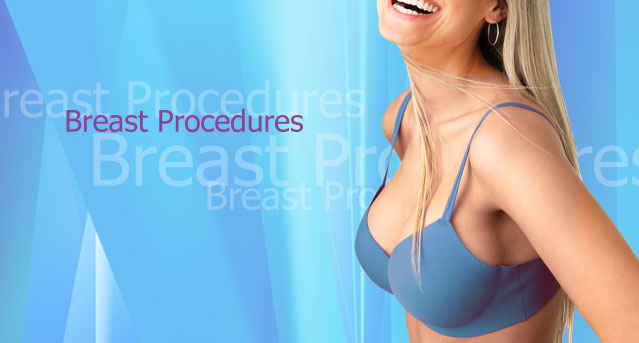
Cosmetic Breast Surgery
There are several types of asthetic breast surgery procedures that can help you achieve the figure you have always wanted. The most well known, and one of the most popular of all types of cosmetic surgery, is breast augmentation. Sagging breasts can be returned to a more youthful position with a breast lift, while women whose breast are too large can benefit from breast reduction.
Breast Augmentation With Implants
Purpose:
To enlarge and reshape the breasts.
Recovery:
1 to 2 weeks out of work, 4 to 6 weeks before strenuous exercise
Outpatient Surgery?:
Yes
Breast augmentation consists of enlarging the breasts by inserting implants under the natural breast tissue or under the chest (pectoral) muscles. There are two types of approved breast implants in the United States, saline-filled and silicone breast implants. Both consist of a shell made of a plastic-like material called silicone. Saline implants are filled with sterilized salt water after they are inserted and can be adjusted in size. Silicone-filled implants are filled at the factory with a thick gel-like type of silicone. Another type of silicone-filled implant that is filled with a very thick type of silicone gel (called a gummy bear implant because the filling is the consistency of the little candies) is under clinical investigation, but has not been approved as yet.
Implants can be inserted under some of the muscles of the chest wall or over the muscles through incisions that can be placed either around the nipple, in the crease under the breast, or in the arm pit. Saline implants can also be inserted through a tiny incision in the belly button. The procedure is generally done as same-day surgery and you go home a couple of hours afterward. Breast augmentation can be combined with other procedures, including liposuction and abdominoplasty (tummy tuck).
No surgery is without risks, and breast augmentation is no exception. The most common problem after breast implants is capsular contracture, which is the formation of a capsule of tight, sometimes painful scar tissue around one or both implants. Other risks include rupture of the implant (which completely deflate a saline implant), infection, or a bad reaction to the anesthesia used. Sometimes, there is no medical problem, but the results are not to your liking. Time out of work for breast augmentation is usually about a week or two, but complete healing takes longer.
Breast Lift Surgery
Purpose:
To restore the breasts to a more youthful appearance.
Recovery:
1 to 2 weeks out of work, 4 to 6 weeks before strenuous exercise
Outpatient Surgery?:
Yes.
Breast lift surgery (medical known as called a mastopexy) raises and reshapes breasts that have stretched out of shape due to pregnancy, breastfeeding, age or gravity. Most women of a certain age realize that their breasts have started to droop. Pregnancy often causes the breasts to enlarge in advance of breastfeeding, and when breastfeeding is finished, the breasts may lose volume and sag.
Several techniques can be used to raise sagging or drooping breasts, and which one is used depends on your surgeon’s preferences and on how much of a lift you need. For minimal breast lifts, the surgeon can make an incision around the nipple or around the lower half of the nipple and remove a ring or crescent of skin. By drawing in the skin and closing the incision, the rest of the breast is lifted and rejuvenated. More extensive lifts may involve an incision around the nipple and down to the crease. Women who have lost a lot of breast volume (or perhaps did not have a lot to start with) can also have breast implants inserted during their breast lift surgery. Again, time out of work is usually about a week, but may be longer for an extensive lift. Swelling may not completely resolve for several weeks. To learn more about breast lift recovery, and other information about cosmetic plastic surgery, visit our sister sites.
Breast Reduction
Purpose:
To reduce the size of the breasts.
Recovery:
1 to 2 weeks out of work, 4 to 6 weeks before strenuous exercise
Outpatient Surgery?:
Possibly no.
Breast reduction is a more involved surgical procedure and is considered to be reconstructive surgery rather than cosmetic. Women who have very large breasts look top-heavy and out of balance, but they may also suffer from backaches, skin infections under their breasts, and sores where their bra straps cut into their shoulders. In some cases, breast reduction surgery may be covered by health insurance.
Because a lot of breast tissue may need to be removed, scarring may be extensive after breast reduction. There is also the possibility that the surgery can make future breastfeeding difficult or impossible. You should consider these factors before deciding to have breast reduction surgery. There are also the risks of infection, excess bleeding, adverse reaction to anesthesia, and having asymmetrical breasts after the surgery.
Breast reduction involves an incision around the nipple and down to the crease. This incision may extend to either side in the crease under the breasts, making the incision look like an old-fashioned anchor. The surgeon then removes excess tissue and skin and closes the incision. In some cases, the nipple is removed completely and relocated on the breast, but usually the surgeon will try to keep the nipple attached to the milk ducts.
Breast reduction involves an incision around the nipple and down to the crease. This incision may extend to either side in the crease under the breasts, making the incision look like an old-fashioned anchor. The surgeon then removes excess tissue and skin and closes the incision. In some cases, the nipple is removed completely and relocated on the breast, but usually the surgeon will try to keep the nipple attached to the milk ducts.
Visit the Consumer Guide to Dentistry to learn about oral health and cosmetic dentistry, and to find a local dentist who performs the procedures.
 |
